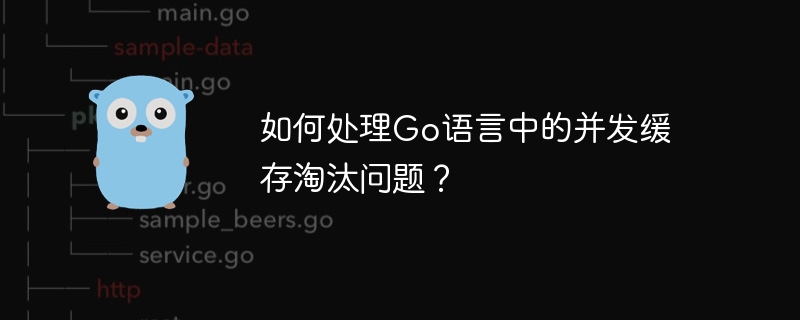
Go 언어에서 동시 캐시 제거 문제를 처리하는 방법은 무엇입니까?
소개
동시 캐시 제거 문제는 개발 과정에서 흔히 발생하는 문제입니다. Go 언어에서는 동시성을 기본적으로 지원하므로 동시 캐시 제거 문제를 처리하기 위한 몇 가지 전략을 채택할 수 있습니다. 이 문서에서는 일반적으로 사용되는 몇 가지 전략을 소개하고 구체적인 코드 예제를 제공합니다.
1. LRU 캐시 제거 전략
LRU(Least Recent Used)는 일반적인 캐시 제거 전략입니다. 캐시가 가득 차면 최근에 가장 적게 사용된 데이터가 새 데이터로 대체됩니다.
Go 언어에서는 컨테이너/목록 패키지를 사용하여 LRU 캐시 제거 전략을 구현할 수 있습니다. 먼저 캐시 크기와 대기열을 포함하는 구조를 정의합니다.
type LRUCache struct {
size int
cache map[string]*list.Element
list *list.List
}다음으로 캐시의 데이터를 가져오고 사용 순서를 업데이트하는 Get 메서드를 구현합니다.
func (c *LRUCache) Get(key string) interface{} {
if element, ok := c.cache[key]; ok {
c.list.MoveToFront(element)
return element.Value
}
return nil
}그런 다음 Put 메서드를 구현하여 캐시에 데이터를 삽입하고 캐시가 가득 차면 가장 오래 사용되지 않은 데이터를 제거합니다.
func (c *LRUCache) Put(key string, value interface{}) {
if element, ok := c.cache[key]; ok {
c.list.MoveToFront(element)
element.Value = value
} else {
if c.list.Len() == c.size {
// 缓存已满,删除最久未使用的数据
evictedElement := c.list.Back()
delete(c.cache, evictedElement.Value.(string))
c.list.Remove(evictedElement)
}
// 新增数据到缓存
element := c.list.PushFront(value)
c.cache[key] = element
}
}2. LFU 캐시 제거 전략
LFU(Least 빈번하게 사용됨, 가장 적게 사용됨)는 또 다른 일반적인 캐시 제거 전략입니다. 캐시가 가득 차면 가장 적게 사용된 데이터가 교체됩니다.
Go 언어에서는 해시 테이블과 이중 연결 목록을 사용하여 LFU 캐시 제거 전략을 구현할 수 있습니다. 먼저 캐시 크기, 해시 테이블, 이중 연결 목록을 포함하는 구조를 정의합니다.
type LFUCache struct {
size int
cache map[string]*lfuNode
frequencyDLL *dll
minFrequency int // 记录当前缓存中最小的使用次数
}다음으로 캐시 데이터와 해당 사용 횟수를 저장하는 노드 구조를 정의합니다.
type lfuNode struct {
key string
value interface{}
frequency int
prev, next *lfuNode
}그런 다음 노드를 저장하기 위한 이중 연결 목록 구조를 정의하고 해당 작업 방법을 제공합니다.
type dll struct {
head, tail *lfuNode
}
func (d *dll) insertAfter(node, newNode *lfuNode) {
newNode.prev = node
newNode.next = node.next
node.next.prev = newNode
node.next = newNode
}
func (d *dll) remove(node *lfuNode) {
node.prev.next = node.next
node.next.prev = node.prev
node.prev = nil
node.next = nil
}마지막으로 캐시된 데이터를 가져와 새 데이터를 삽입하기 위한 Get 메서드와 Put 메서드를 구현합니다.
func (c *LFUCache) Get(key string) interface{} {
if node, ok := c.cache[key]; ok {
c.updateNode(node)
return node.value
}
return nil
}
func (c *LFUCache) Put(key string, value interface{}) {
if c.size == 0 {
return
}
if node, ok := c.cache[key]; ok {
node.value = value
c.updateNode(node)
} else {
if len(c.cache) >= c.size {
c.removeNode(c.frequencyDLL.head.next)
}
newNode := &lfuNode{key: key, value: value, frequency: 1}
c.addNode(newNode)
c.cache[key] = newNode
}
}
func (c *LFUCache) updateNode(node *lfuNode) {
c.removeNode(node)
node.frequency++
c.addNode(node)
}
func (c *LFUCache) removeNode(node *lfuNode) {
dll := c.frequencyDLL.getDLL(node.frequency)
dll.remove(node)
if c.minFrequency == node.frequency && dll.head.next == nil {
c.minFrequency++
}
delete(c.cache, node.key)
}
func (c *LFUCache) addNode(node *lfuNode) {
dll := c.frequencyDLL.getDLL(node.frequency)
dll.insertAfter(dll.head, node)
if dll != c.frequencyDLL.head.next && dll.head.next == node {
c.frequencyDLL.getDLL(node.frequency - 1).remove(node)
}
if c.minFrequency == 0 {
c.minFrequency = node.frequency
}
c.cache[node.key] = node
}결론
위는 Go 언어의 동시 캐시 제거 문제를 처리하기 위한 두 가지 일반적인 전략인 LRU와 LFU입니다. 적절한 데이터 구조와 알고리즘을 사용하면 동시 캐시 제거 문제를 효율적으로 해결할 수 있습니다. 이 기사의 코드 예제가 독자가 이러한 전략을 더 잘 이해하고 적용하는 데 도움이 되기를 바랍니다.
위 내용은 Go 언어에서 동시 캐시 제거 문제를 처리하는 방법은 무엇입니까?의 상세 내용입니다. 자세한 내용은 PHP 중국어 웹사이트의 기타 관련 기사를 참조하세요!